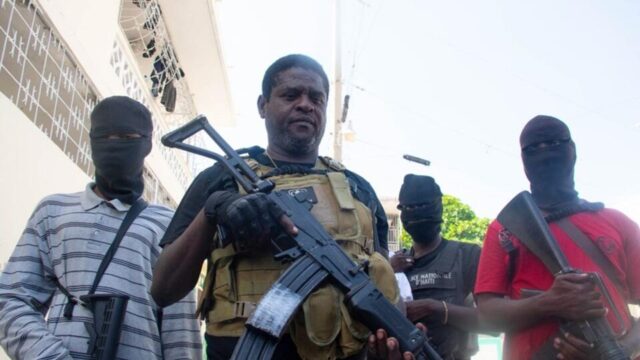Citizens living in the tiny, cash-strapped Caribbean nation of Haiti have come to know what hell on earth feels like, after armed gangs, once supported by political leaders, have overthrown the government and gained control of the island state, displacing thousands.
CITIZENS living in the tiny, cash-strapped Caribbean nation of Haiti have come to know what hell on earth feels like, after armed gangs, once supported by political leaders, have overthrown the government and gained control of the island state, displacing thousands.
Using violence, extortion and kidnappings, the country has close to 200 armed gangs operating within its borders, with around 95 in the capital of Port-au-Prince alone, according to a study by the Global Initiative Against Transnational Organised Crime.
In recent weeks, international media outlets have been in a frenzy over the escalating situation in Haiti, after Prime Minister Ariel Henry was ousted and a new leader had seemingly risen.
The leader of the G9 gang and former police officer Jimmy Chérizier, who is responsible for bringing together gangs operating in the capital, has emerged as a leading figure amid the collapse of the Haitian government.
But according to Chérizier, during an Al Jazeera interview, the gangs only want what’s best for Haiti, which was not envisioned by former leaders, including the last elected president, Jovenel Moïse, who was assassinated on July 7, 2021.
Chérizier said the decisions regarding the future of Haiti must be made by those in the country, not outsiders.
“It’s not just people with guns who have damaged the country, but politicians too,” Chérizier was quoted as saying.
But Haitian gangs did not spring up overnight, nor did they force their foot into the door, but rather, they were let in by state leaders to do their “dirty work”, the report indicates.
A timeline constructed by the authors show that armed gangs have operated alongside the Haitian government since 1958, during the coup of “Papa Doc” Duvalier’s reign.
The report details how political and state leaders employed the use of armed gangs to wipe out their competition and cause disturbances wherever they are required.
Between 1994 and 2004, young people from the working class neighbourhoods associated with Aristide’s Lavalas political movement set up local self-defence groups.
Jean-Betrand Aristide was President from 2001 to 2004.
“Over the years, these youth gangs were fused with the state police to form a group at the service of Aristide and Fanmi Lavalas – the social-democratic political party that arose from the movement. These gangs took control of the communes of Cité Soleil,” the report states.
Their power, influence, tactics and weaponry have expanded and improved over the last two decades, throughout the reign of Haiti’s leaders since Aristide, including Boniface Alexandre, René Préval, Michel Joseph Martelly, Jovenel Moise to the last PM, Henry.
Enter Jimmy “Barbeque” Chérizier.
It was during the reign of Moise, whose wife was allegedly involved in his assassination, that Chérizier started making moves to the top by forming alliances with warring gangs in Port-au-Prince.
In 2017, during the Grand Ravine massacre, 200 Haitian police raided the Grand Ravine area, in an anti-gang operation that ended up with the execution of innocent civilians on a school campus.
A year later, members of Moïse’s government allegedly assisted in massacres by providing gangs with money, weapons, police uniforms and government vehicles used in attacks in Port-au-Prince.
In response to the rise in violence, and to get a firmer grip on power in the capital, Chérizier united the G9 with some of the most powerful gangs in Port-au-Prince to form his own federation.
The G9 gang is allegedly affiliated with the social democratic ruling party, while the G-pep, a rival gang in the capital, is affiliated with the opposition party, the report states.
Since then, these two gangs have grown exponentially in power and size and have continued waging war against one another, and in the background, hundreds of thousands of Haitians have had to flee their homes and seek refuge, with all forms of government now a thing of the past.
Once aligned with PM Henry, Chérizier later called for his removal from office, after mounting speculation of his involvement in the murder of President Moise grew.
This was due to Henry’s alleged relationship with the main suspect in Moise’s murder, Joseph-Félix Badio.
With Port-au-Prince’s economic and social situation crumbling under the weight of the gang violence, only a few key institutions remain in operation, but they too face an imminent threat.
Security forces in Haiti killed at least three people, repelling an attack on the central bank as gang violence surged in the capital of Port-au-Prince, AFP reported last week.
The UN children’s agency chief offered a dire assessment of the chaotic situation in Haiti, saying it was “almost like a scene out of ‘Mad Max’“, which depicted a violent and lawless post-apocalyptic future.
“Many, many people there are suffering from serious hunger and malnutrition and we’re not able to get enough aid to them,” Unicef executive director Catherine Russell told CBS.
“It’s almost like a scene out of ‘Mad Max’. That’s what it seems like,” Russell was quoted saying.
– AFP








